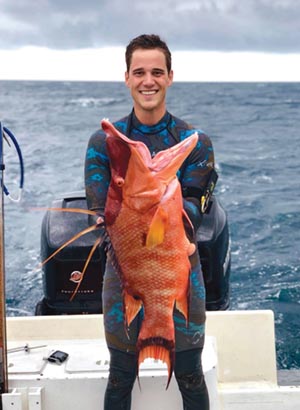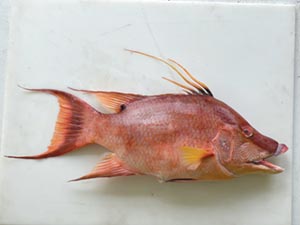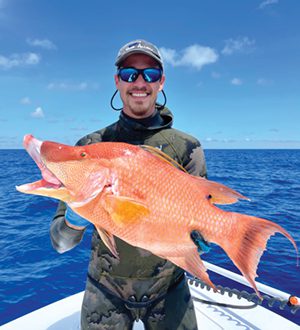By: Michael Sipos, Florida Sea Grant agent, UF/IFAS Extension
Hogfish are a unique species that belong to the diverse Labridae family, which includes over 600 fish known as wrasses. These fish are the largest of the Western Atlantic wrasses, reaching lengths of up to 3 feet. Hogfish are sometimes called hog snapper but do not belong in the snapper family. In fact, their common name is a result their pronounced snout and hog-like rooting behavior they use while searching for prey in the sand.

Hogfish are all born female and later transition to males later in life due to social cues in their local population. These fish spawn in groups where one male can have a harem of multiple females. When the male is removed from the population, the largest female begins her transition to male and develops a more dramatic sloping snout as well as darker pigmentation around the face, almost resembling a mask.
It is believed the female-to-male transition can take up to two months, internally, while the external characteristics continue to become more pronounced over time. Sex change from female to male in a typical population occurs at around 3 years of age and 14 inches fork length; however, if there are no cues to transition, there have been documented females as old as 12 years of age and around 25 inches with the oldest hogfish found to be a male at 23 years of age.

When considering seafood sustainability, hogfish harvested in the United States with hand implements are listed as a best choice by the Monterey Bay Seafood Watch. The International Union for Conservation of Nature has listed the species population as “declining,” which is supported by the yearly number of commercial landings in Florida. That makes it important to take proper care when handling and releasing this fish if caught on hook and line or follow most current fisheries regulations.
— For more fishy content and updates on upcoming educational programs check out the UF/IFAS Extension Collier County Florida Sea Grant Facebook Page, YouTube Channel, or Michael Sipos’s UF/IFAS Blog. Contact Michael Sipos at sipos624@ufl.edu.
Michael Sipos is the Florida Sea Grant agent for UF/IFAS Extension, an equal opportunity institution. Contact him at sipos624@ufl.edu.
For more fishy content and updates on upcoming educational
programs, please check out the Sea Grant Facebook page, YouTube
Channel, Instagram listing or Michael Sipos’ UF/IFAS blog.

